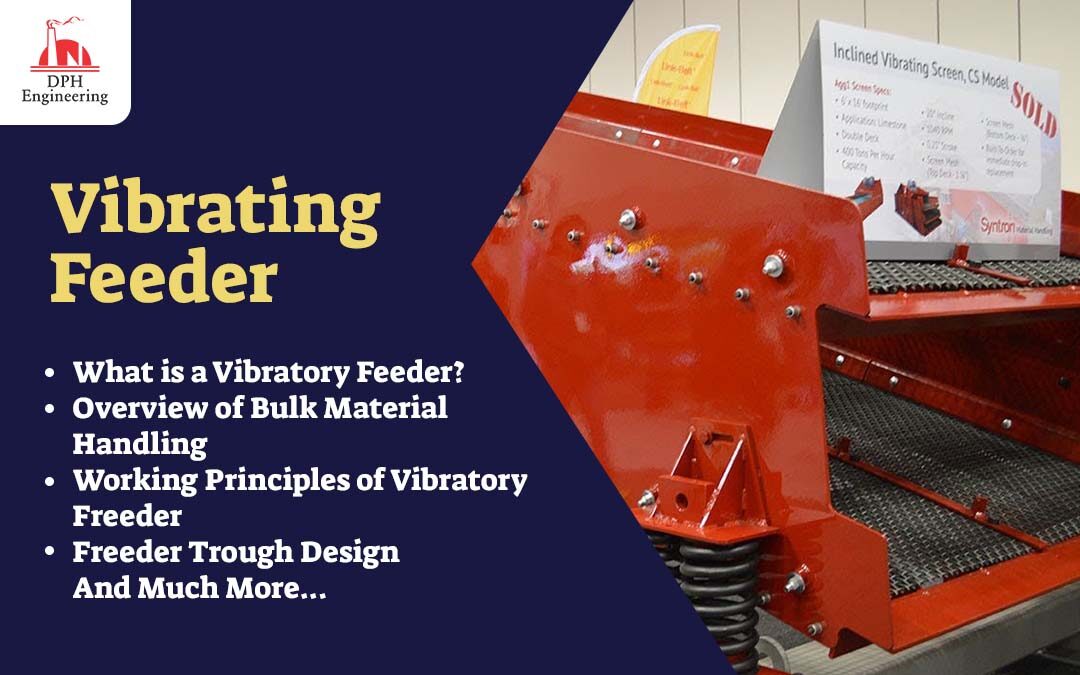A vibratory feeder is a system that uses vibrations to move parts or materials into place for assembly. It relies on controlled vibrations, gravity, and guiding tracks to position materials accurately. These feeders, including the vibro feeder, come in various sizes to fit the needs of different applications. Vibratory feeders help transport and feed bulk materials efficiently by using different vibration types to get materials in the right spot for production. They employ both horizontal and vertical vibrations to move items smoothly along the feeder.
The track slows down the vibrations and guides the material in the right direction. The vibrations are powered by motors, which can be electromagnetic, pneumatic, or piezoelectric. Materials are placed on a trough or platform, where they are moved by vibrations that cause them to jump or slide along. The speed is controlled by adjusting the vibration’s frequency, strength, and angle. Vibratory feeders manage the flow of materials effectively, similar to how valves control liquids and can handle a wide range of quantities, from a few pounds to several tons per hour. They also help prevent blockages by ensuring materials move freely through the feeder.
New designs feature enclosed feeders to minimize dust or spills, making them easier to install and maintain.
Overview of Bulk Material Handling
Bulk materials consist of dry solids like powders, granules, or particles that vary in size and density. These materials behave differently based on factors like temperature and humidity and do not flow as easily as liquids or gases. Additionally, they can damage equipment during handling.
Understanding the properties of bulk materials is key to designing the right equipment. Factors include:
- Adhesion: The material’s tendency to stick to surfaces, which can block the flow.
- Cohesion: The material’s ability to stick to itself, making it harder to move.
- Angle of Repose: The steepest angle a material can form when piled, showing how easily it flows.
- Angle of Fall: The slope created when a force is applied to a piled material.
- Compressibility: The percentage difference between packed and loose material density, affecting size, shape, and water content.
- Bulk Density: The weight of material per unit of volume, important for equipment sizing and strength.
- Moisture Content: The amount of water in the material, with high moisture making materials harder to handle.
- Abrasion: The material’s ability to wear down equipment surfaces.
| Bulk Material | Typical Size Range |
| Coarse Solid | 5 – 500 mm |
| Granular Solid | 0.3 – 5 mm |
| Coarse Powder | 100 – 300 µm |
| Fine Powder | 10 – 100 µm |
| Superfine Powder | 1 – 10 µm |
| Ultrafine Powder | < 1 µm |
Working Principles of Vibratory Feeders
A vibratory feeder consists of a drive unit that creates vibrations and a trough to hold the material. The vibrations result from both horizontal and vertical forces, moving the material in a straight line. Key components include:
- Feed End: The starting point where material enters the trough.
- Discharge End: The exit point where material leaves the feeder.
- Eccentric Weight: An off-balance weight that creates vibrations.
- Reactor Springs: Store and release energy during operation.
- Isolation Springs: Support the feeder and prevent vibrations from affecting the structure.
- Dynamic Balancer: Reduces the force transferred to the supporting structure.
Vibratory feeders operate at 200 to 3600 vibrations per minute, gently moving materials with low noise. Unlike conveyor belts, vibratory feeders allow additional processes like screening, sorting, and cooling during transit. Key benefits include:
- Low headroom for tight spaces.
- Handling of hot or abrasive materials.
- Self-cleaning design.
- Compliance with sanitation standards.
These features make vibratory feeders popular in industries like mining, food processing, and packaging.
Types of Vibratory Feeders
Vibratory feeders can be categorized based on their drive units, vibration methods, and how they affect supporting structures. Here are the main types:
- Electromechanical Vibratory Feeders: These use electric motors and eccentric weights to create vibrations. They can have one or two weights rotating to produce oscillations.
- Electromagnetic Vibratory Feeders: These feeders use electromagnets that turn on and off to create vibrations. They have fewer moving parts and are cost-effective for low-volume applications (under 5 tonnes per hour).
- Hydraulic and Pneumatic Vibratory Feeders: Powered by hydraulic or pneumatic systems, these feeders are suitable for dangerous areas as the motors can be located remotely.
- Direct Vibratory Feeders: These create low-frequency, high-amplitude vibrations using a crank and connecting rod. They are less common due to high vibrations affecting the supporting structures.
- Brute Force Feeders: These have a direct connection between the drive and the trough. They are simple but not adjustable for variable speeds.
- Centrifugal Feeders: These feeders use a revolving bowl to push components outward. They efficiently sort and orient small parts at high speeds, ideal for food and pharmaceutical industries.
- Natural Frequency Feeders: These use spring-connected masses to operate near their natural frequency, which amplifies vibrations. This design requires less force to create movement.
- Unbalanced Vibratory Feeders: These create fluctuating forces that can wear down supporting structures. They require robust supports that can handle the stress.
- Balanced Vibratory Feeders: These use counterbalancing weights to minimize stress on structures. They are recommended for installations where support rigidity is a concern.
- Horizontal Motion Conveyors: These move bulk materials horizontally using a slow forward and quick return motion, ensuring smooth transport with minimal bouncing. They are ideal for delicate products.
Understanding these types helps choose the right feeder for specific applications.
Feeder Trough Design
The capacity of a vibrating feeder depends on several factors: the width and depth of the trough, the material’s bulk density, and the feed rate. The formula for calculating capacity (C) is:
C=W×d×R4800C = \frac{W \times d \times R}{4800}C=4800W×d×R
Where:
- CCC: Capacity (tons per hour)
- WWW: Trough width (inches)
- ddd: Depth of material (inches)
- RRR: Linear feed rate (feet per minute)
Feeder troughs are typically made from materials like stainless steel grade 304 or mild steel. They can come in various shapes, including:
- Flat Bottom
- V Shape
- Grizzly Section
These designs optimize performance based on the material being fed.
Vibratory Bowl Feeders
Vibratory bowl feeders have helical troughs that use vibrations to move and shuffle materials along a slightly tilted surface. This tossing and shuffling action helps align parts with irregular shapes as they move through the feeder.
The main benefit of a vibratory bowl feeder is its ability to both transport and correctly orient parts. The troughs are designed with specific profiles to accept materials in the right position. Any misaligned parts are removed by screening equipment attached to the bowl. These feeders are commonly used in assembly and packaging lines in industries like electronics, automotive, and pharmaceuticals.
Features to Consider When Buying a Vibratory Feeder
When buying a vibratory feeder, consider a few key factors to ensure it’s the right choice for you. First, check how much energy it needs to operate. Next, think about how quickly it will sort and convey materials to meet your company’s needs. Remember, repairing a vibratory feeder is usually cheaper than repairing a mechanical feeder. Ask yourself if it fits your budget and daily goals.
Conclusion
Vibratory feeders are small conveyors that move bulk materials using gravity and vibrations. These vibrations create a mix of horizontal and vertical movements, helping materials like powders and granules move along the trough.
The basic structure of a vibratory feeder includes a deep trough to hold the bulk material and a driving unit that creates the vibrations. Vibratory feeders can be classified based on their drive units and how they interact with their supporting structures.
Vibratory bowl feeders are a specific type of feeder with helical troughs designed to orient parts correctly for feeding applications.
For more information, contact us!
DPH Engineering is one of India’s leading distributor of industrial machinery. We provide modern tools and excellent service, even after the sale. If you’re thinking about adding conveyor belts to boost your assembly line productivity, reach out to us! We specialize in designing, manufacturing, repairing, and installing material handling equipment.
Explore Our Related Blog
FAQs
What is the principle of a vibration feeder?
The principle of a vibratory feeder is simple. It works by making the feeder tray vibrate, which helps move materials. Vibratory feeders use controlled vibrations to transport bulk materials. When products are placed in the feeder tray, the vibrations push them along, allowing for efficient movement and handling.
What are the mechanics of vibratory feeding?
Vibratory feeders work through vibrations, rotation, and force, which can be generated by piezoelectric, electromagnetic, or pneumatic motors in the drive units. The process begins with a trough or platform that transports materials. Controlled linear vibrations cause the materials to jump, hop, and toss, moving them along the feeder.
What is a linear vibratory feeder?
A linear vibratory feeder is a type of material handling equipment used in industrial settings to move and distribute large quantities of materials. An example of this is the Gough Linear Vibratory Feeder (GLVF). These feeders use vibrations to convey materials in a straight line, making them efficient for handling various bulk materials.


